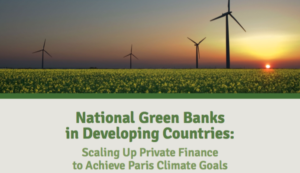

Click here to download the paper.
The Coalition for Green Capital (CGC), with support from the Hewlett Foundation, has published a new paper exploring how the Green Bank model can be implemented in emerging markets to help achieve national climate goals. The paper examines how Green Banks (either purpose-built entities or adaptations of existing institutions) can be effective in channeling investment from carbon to clean in emerging economies and in driving global clean energy investment to the scale required to achieve international climate goals.
With the Paris agreement in place, the burden of climate action has shifted from international discussion to nation-specific implementation. And with that shift it becomes clear that far more investment, primarily from the private sector, will be needed to meet local climate goals and Nationally Determined Contributions (NDCs). Existing climate policies and investment pledges are projected to yield far less global climate investment than what is needed to keep temperature rise below two degrees Celsius. There is a $27 trillion investment shortfall that must be filled. New approaches are needed to drive private investment at unprecedented scale, and quickly. An additional hurdle is that investments must offer attractive returns while also delivering affordable clean energy solutions to customers. This challenge is particularly acute in developing economies where issues of energy access and affordability are central to the clean energy transition.
National Green Banks – structured as either new purpose-built institutions or adaptations of existing institutions – can be developed around the world to address critical market gaps and drive public and private climate investment. Green Banks are public-purpose finance institutions dedicated to green investment, embodying the pure focus and local market-oriented approach needed to fill the investment shortfall. In multiple countries, Green Banks have successfully driven investment into clean energy infrastructure in their local markets. Green Banks are designed to maximize total investment, using limited public funds to leverage far greater private investment. By developing innovative finance and market development solutions, Green Banks address barriers that currently restrict clean energy market growth.
Since initiating work on this scoping effort in January 2017, interest in the Green Bank model has grown and is seeing increased visibility as a promising option for expanding the climate finance architecture in developing countries. A promising cohort of countries is emerging as an early proof-of-concept opportunity for the Green Bank model including South Africa, Mexico, Chile, India, Morocco, the Philippines, Colombia, and others.
“To achieve zero net greenhouse emissions globally by the end of this century, governments need to make full use of their capacity to leverage and unlock much larger flows of private investment in low-carbon infrastructure. Public green investment banks can help accelerate the shift to low-carbon investment at the national and sub-national levels.”
– Angel Gurría, OECD Secretary-General
CGC recognizes that creating a replicable Green Bank model for scaling up climate will require the combined efforts of a consortium of expert organizations. We are working to develop a collaborative framework to support the design and capitalization of 4-6 institutions that can be operational by approximately 2020 and serve as models for replication by others. Initial non-profits and intergovernmental organizations involved in this collaborative effort include the Coalition for Green Capital (CGC), Rocky Mountain Institute (RMI), Natural Resources Defense Council (NRDC), Climate Policy Initiative (CPI), and the Organization for Economic Cooperation and Development (OECD) and are joined by several partners from the for-profit consulting community (Climate Finance Advisors and Rick Nogueira).
“National green investment banks (GIBs) offer a replicable model for moving the locus of problem-solving and agency to the national level, empowering developing countries to benefit from international financial resources while also better attracting private capital. This model can serve as the centerpiece of a radically more efficient and effective climate finance architecture that enables the fulfillment of ambitious Nationally Determined Contributions (NDCs).”
–Paul Bodnar, Managing Director, Rocky Mountain Institute
To inform our work, CGC conducted a series of interviews and a stakeholder work-session with more than 100 representatives of development financial institutions, national development banks, developing country representatives, existing Green Banks, capital providers, climate funds, thought leaders, government officials and others from the climate finance community. We also worked closely with a core group of expert organizational partners to help inform and shape our recommendations on application of the Green Bank model.